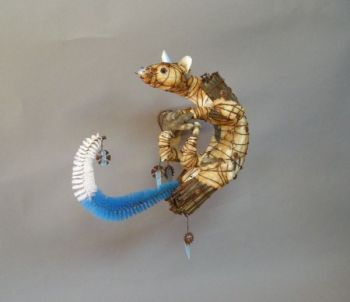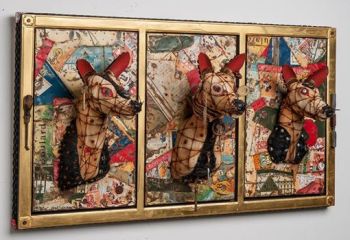

Gorman’s fondness for animal subjects and use of found materials comes largely from his upbringing. He had a self-described “Huck Finn” experience of youth. He spent his childhood exploring the barns and woods of an old plantation outside of Baltimore, Maryland, that his father had bought in the 1960s. The menagerie of pets, both domestic and wild, he kept as a child explains his fascination with animals.
“My father loved animals, so in my growing up we usually had four or five dogs,” said Gorman. “At one time, I had a pet fox, a pet raccoon and a pet monkey. I had all these different animals – a lot of animals that I caught, like snakes and squirrels. My father was a big, big nature lover, so I really grew up loving animals.”
The materials Gorman uses also spring from his childhood experiences and environment. “It’s a real kind of throwback to being a kid, and I think the patina that I get with the material that I use … in other words, it feels rusted. And this representation of the passage of time, I think comes from growing up on our old farm and the sort of stuff we had lying around. And that’s the surface I love the most. So, I think a lot of my art is a throwback to being a kid.”

“I try to use what we refer to as trash -- stuff that’s been discarded, and I’m trying to elevate the trash into something else. In the art world, everything is so precious and it’s so exclusive – there are the people in the know and the people that aren’t – but I’m taking this valueless stuff and I’m giving it a value. Value is so arbitrary. I’m not trying to trick people, but I’m trying to say to people that a lot of life is about transformation.”
Gorman finds these bits of “nothing” in his travels and from organizations such Habitat for Humanity. An old rock he picked up on a beach in Alaska turns into “this really precious, almost kind of a jewel that a squirrel is holding, and the squirrel believes it is holding something really precious,” said Gorman.

Despite their inorganic skeletons and accoutrements, Gorman’s animals are very much alive. He creates vivid stories around and imagines interactions and relationships among his animals. They have thoughts, feelings, motives and desires – just like humans. Despite the feral appearance of his animals, the agency he ascribes to his sculptures makes them highly anthropomorphized. With the stories he builds around his creations, Gorman treads a paradoxical line between the wild animal and the human animal. Or perhaps he erases any divide at all.
Take, for instance, Gorman’s explanation of the things, “old screws and washers and nuts and bolts, maybe it’s a door handle” that hang off of his animals.

“I believe animals are just like humans,” said Gorman. “Or I should say, maybe humans are just like animals, but we’ve kind of elevated ourselves and made ourselves feel more important. I’m using the animals as a metaphor of the human condition. As we destroy ourselves, how are we going to survive, really?”
The stories Gorman creates around his animals are often about survival. These creatures, though human-like in many ways, are at odds with humans, who threaten their existence.

One particularly vivid example of this theme is that of an escaped circus baboon: “A couple of years ago, I was doing some baboons and I got it in my mind. I started stenciling on old canvas, stenciling letters that didn’t make any sense, and then I realized that I had made a name and I put [the canvas] on this baboon as a cape. The story turned out that he had been a baboon in one of these small traveling circuses and hated it because he was really badly treated. So one night, he broke out and ripped the banner down that had his name on it and used it for warmth at night. Then, he took the balls he had to juggle in shows to use as weapons to fight against humans. And on his arm is a metal plate, a plate that was on him that said his name. Actually, I sold that piece right away telling that story. It seemed to resonate with people. How did I come up with it? It kind of started with just spraying the canvas. In some ways, I’m trying not to over-think or get an end result of where I’m going. I try to just stay open to stuff. I’m trying not to be too intellectual about it.”
In Gorman’s story, the animals also appropriate the objects to rise up from the destruction wrought by humans. The same thing that destroys his animals defines them. “But at the same time what they’re also doing is, as we use up our resources and destroy the natural world, they’re taking what is cast off and reusing those objects to rebuild themselves,” he said.

I asked Gorman what he hoped people would take away from his work when they saw it. His response? “That’s funny that I don’t have an answer to that question.”
Despite his uncertainty regarding his ultimate take-away message, his work provokes reactions from those who view it. Gorman’s animals, both with their harrowing sinews and the notion, if perceived, that they are fighting back against humanity, disturb some people – and he likes that. “Some people are really frightened of my work, which to me is a really good response,” said Gorman. “I would like for [my work] to have an edge.”
Gorman isn’t always forthright about the darker context of his work. “In fact, my dealers don’t really like me to say that,” he admitted. “They want them to be more cutesy, just friendly little animals.”

But even without the backstory, people tend to have an innate aversion to the emaciated, feral look of his animals.
“What I want with my animals, in a way, is that I want you to be able to see both their inside and their outside,” explained Gorman. “The animals, in some ways, are deteriorating, and when you see the sticks, you’re seeing their bone structure. Skin is rotted off. People think they’re seeing the raw animal. I think a lot of people are scared of nature, scared of being confronted face-to-face by animals that aren’t controlled. I know that sounds trite, but I do believe that. And a lot of people tell me how much they hate ravens, which to me is just mind boggling because I think they’re such incredible animals. And people will tell me how much they hate coyotes ... and you know, it’s the weirdest damn thing. There’s this big disconnect from the natural world.”
“People say to me, ‘Your animals, they’re really skinny! Why don’t you have a fat animal?’ and I tell them, in the wild, in the survival situation, no one is fat. It’s a rough world out there. We can make it this really cute, kind of pretty, kind of ‘isn’t that adorable’ [thing], but if you study a wolf pack, they’re some of the most violent animals I’ve seen … if a wolf comes into another pack’s territory, it’s a bad scene. I mean, they are not any kind of cutesy 'look at these animals.’ They have to be really with it, they have to be really sharp.”

“I just finished a piece, a dog on a chair barking at a squirrel. That one is more humorous. The squirrel has been working out at the gym – if you look at his shoulders they’re really buff – and he has this big rock and he really wants to throw it at this dog that has been annoying him. This dog has a sunburned nose, so it’s really worried that the rock is going to hit his nose, but he’s also really pissed off at the squirrel. So they’re kind of having this dialogue as to who is going to get the best of whom. I like the storytelling.”
All his animals have an element of the human about them through the stories he creates, which is interesting given that he tries to think like an animal to craft the stories.
“One thing that I do is try to think like animals,” Gorman explained, “and I try to look out from their eyes to see what it is really like to exist, and I imagine I’m way, way off, but that’s what I try to do. I’ve started doing keynote speeches, and the title of my lecture is, ‘I Am Still an Animal,’ and I do believe that we are more animal than human but we’ve really tried to hide that, which is really a shame.”

In the end, Gorman’s work means different things to different people, just as our perception of and relationship with animals varies according to culture, society and experience. “Animals mean different things to different cultures. So when you enter into a different culture, an animal may take on a totally different meaning,” said Gorman.
In some ways, Gorman’s animals remind me of a modernized, almost post-apocalyptic version of Aesops’ fables, anthropomorphized animals that teach us about ourselves. His animals are mirrors that reflect back ourselves and our relationships to nature.
If you’re interested in seeing more of Geoffrey Gorman’s art, please visit his website.